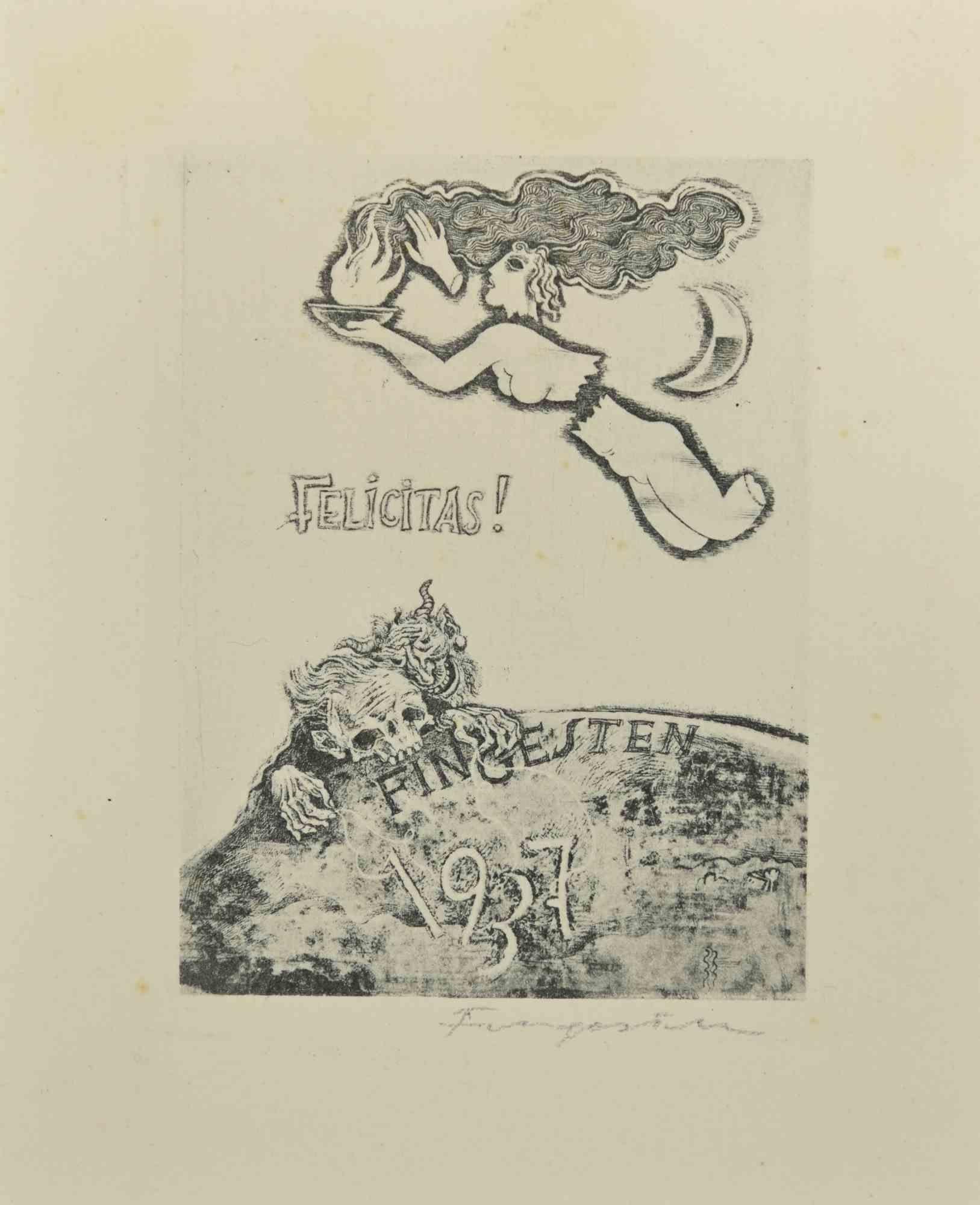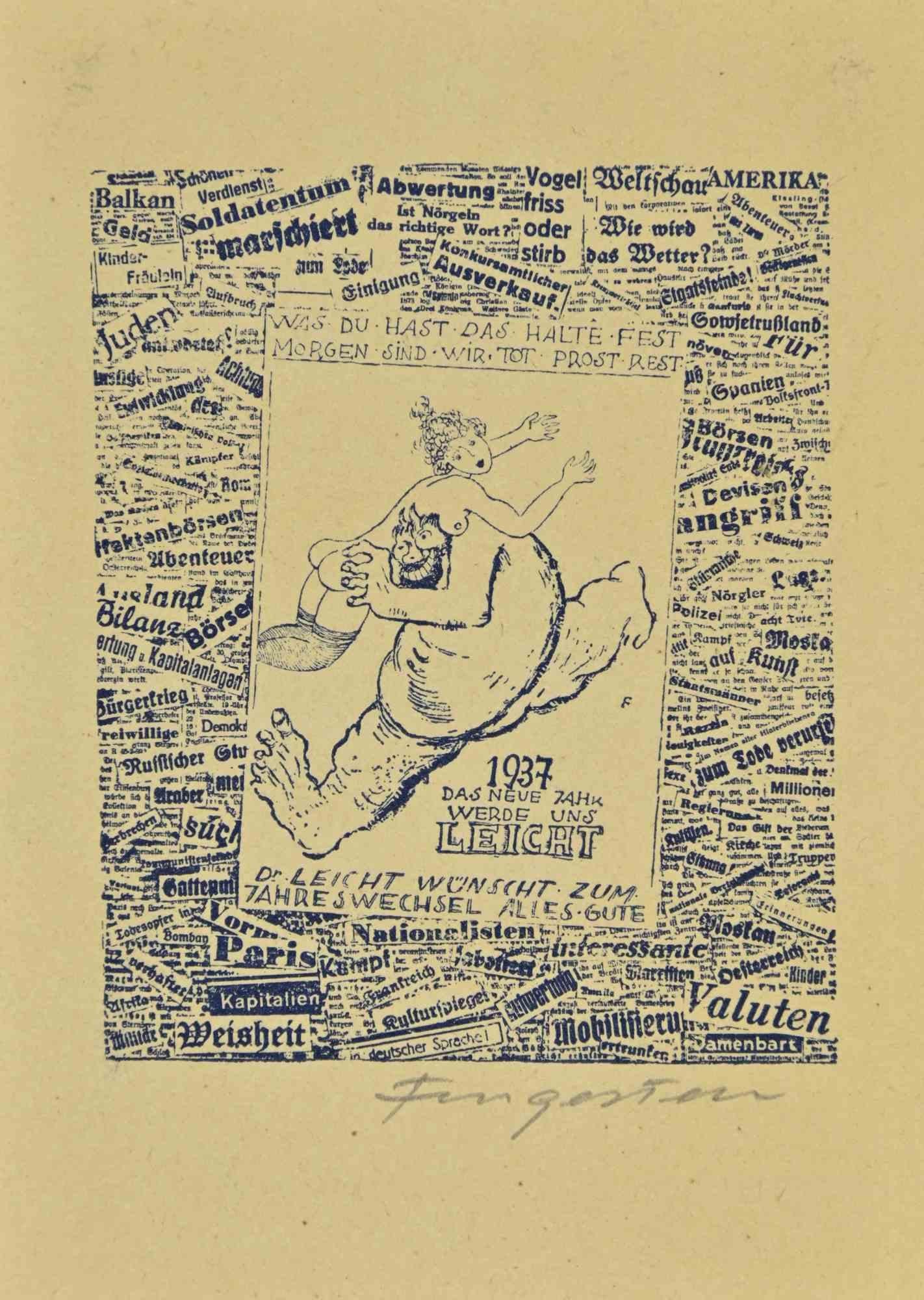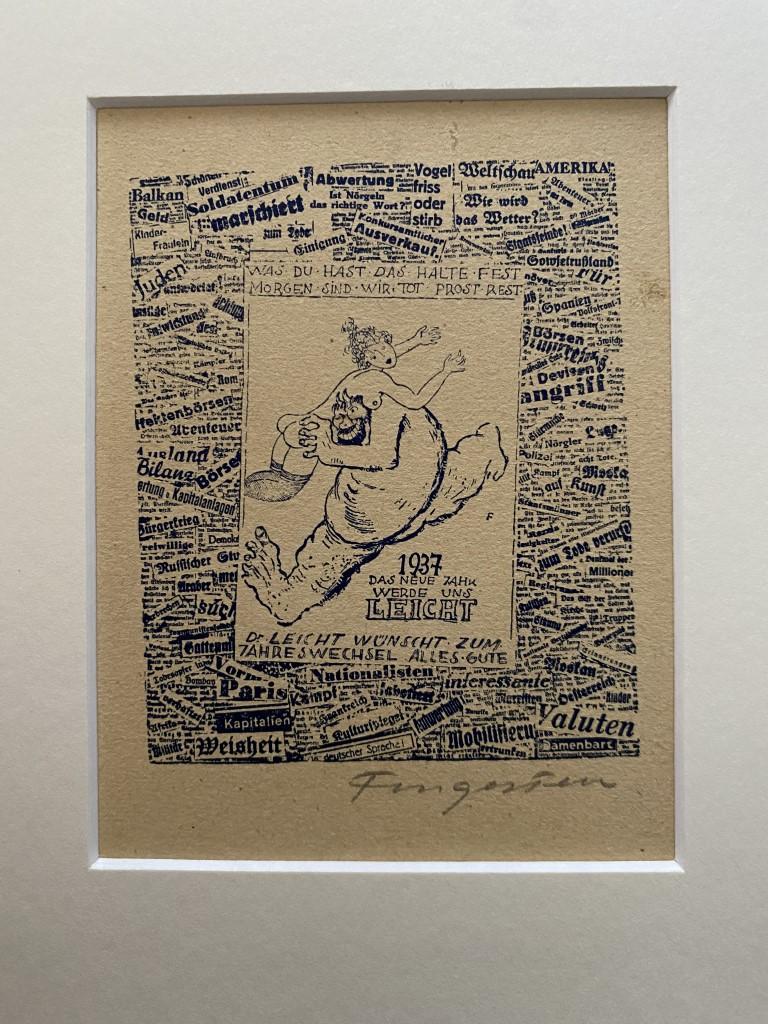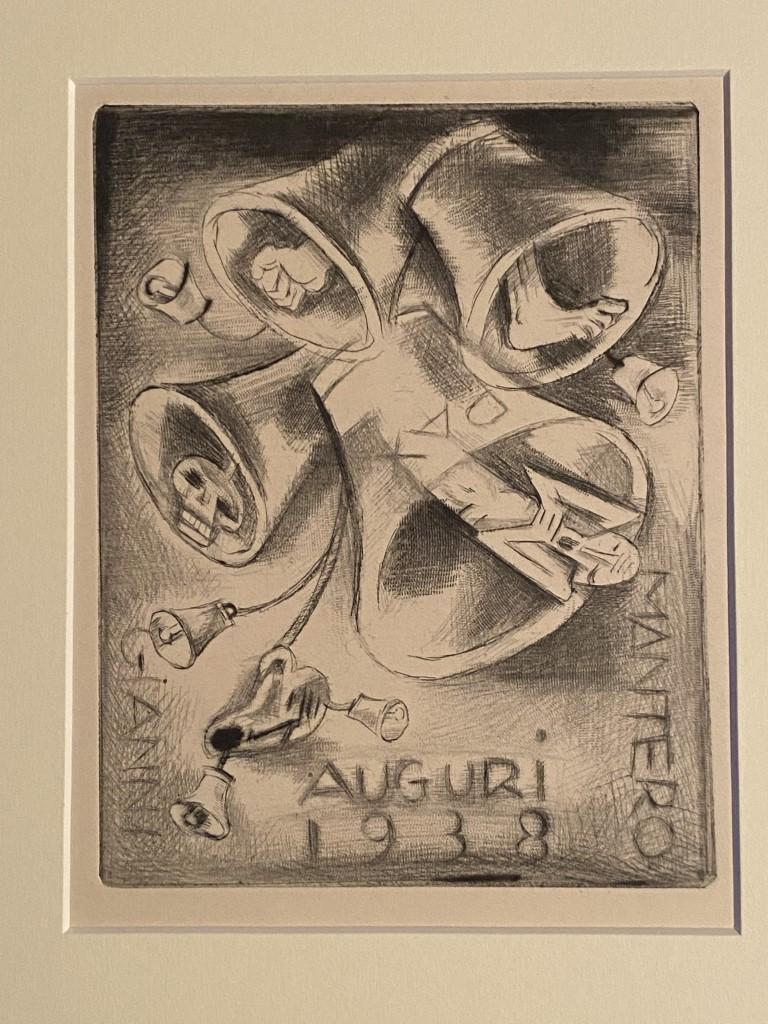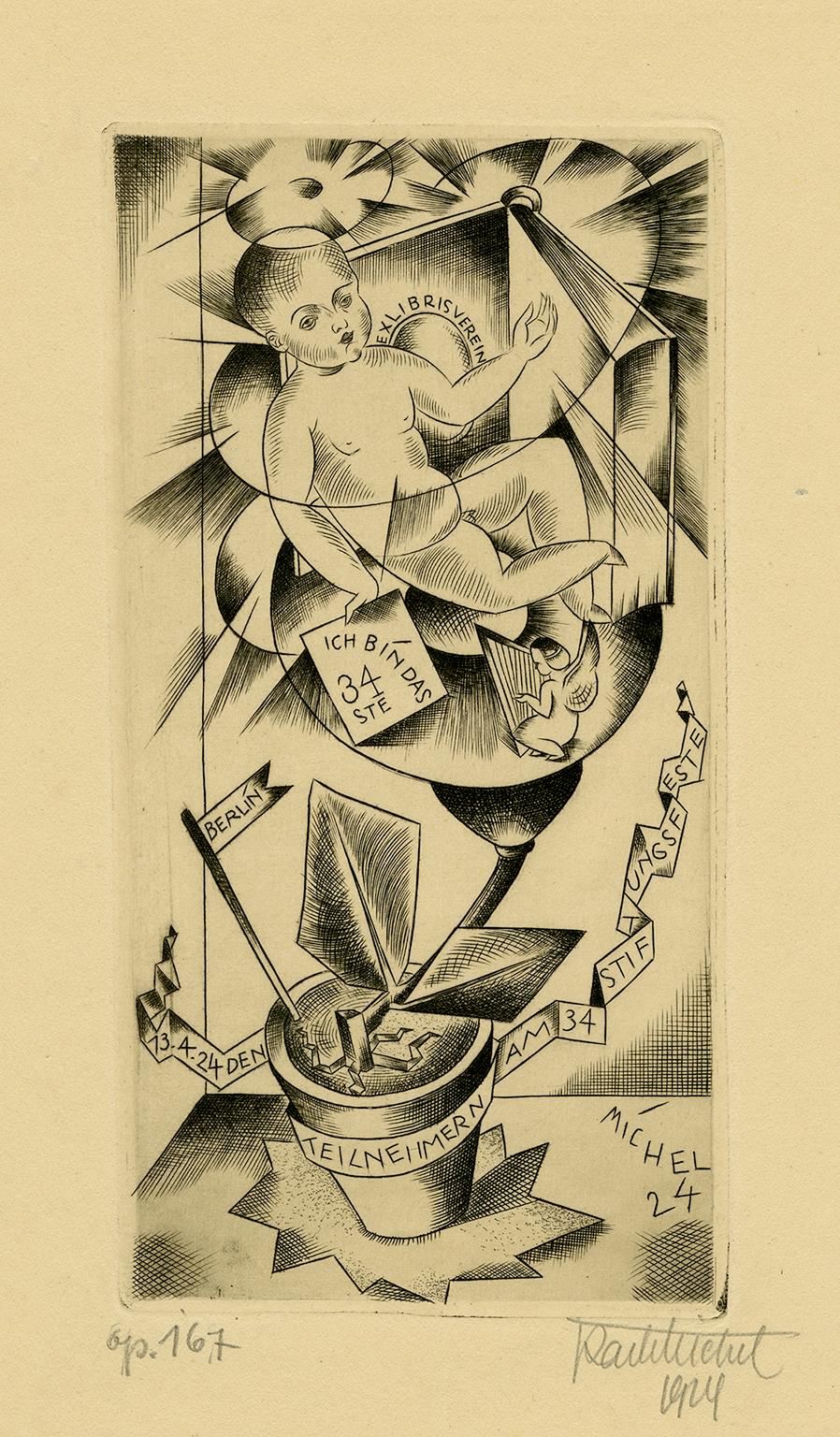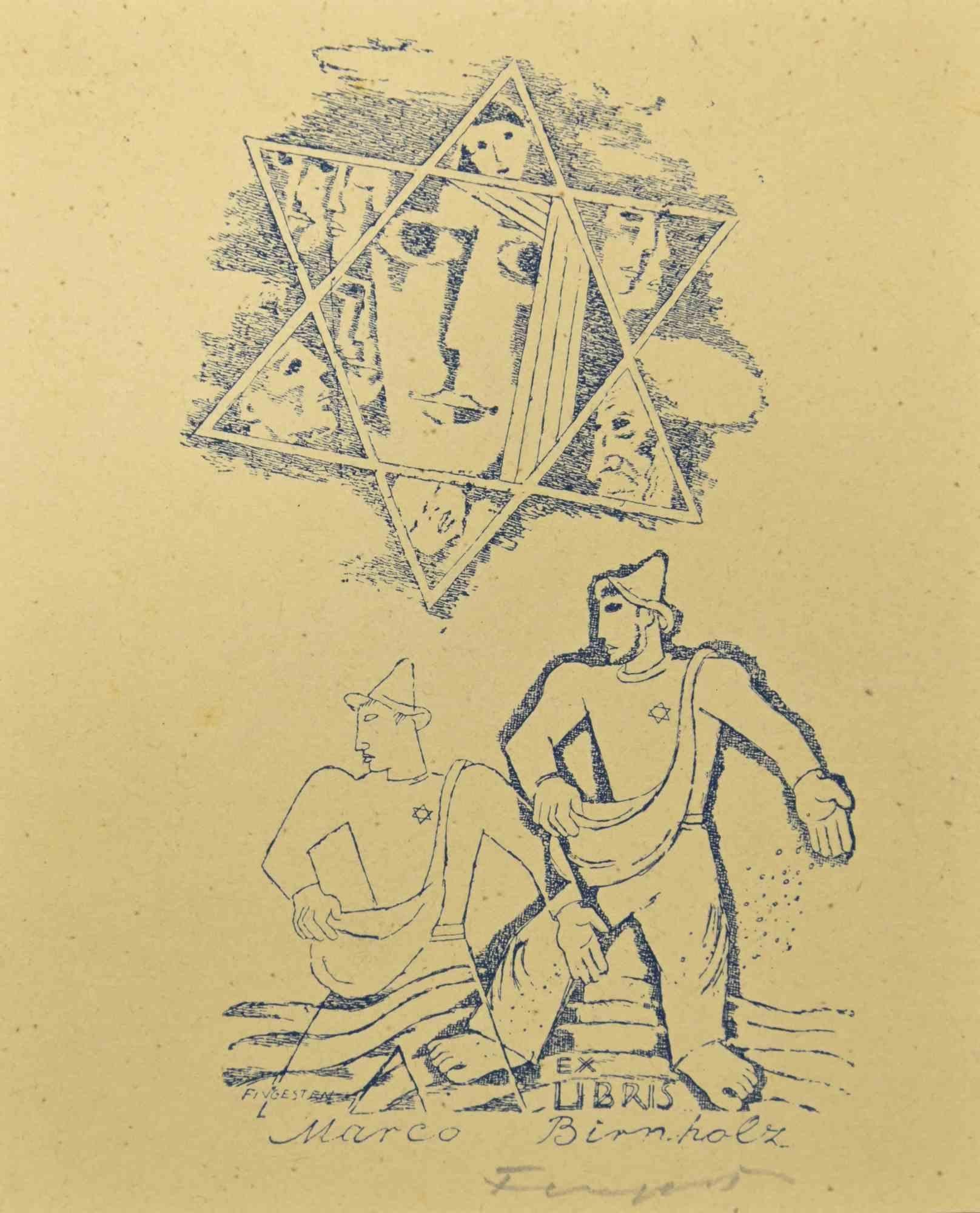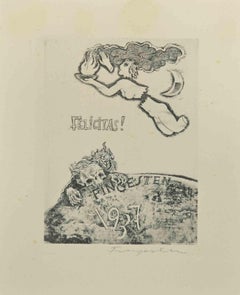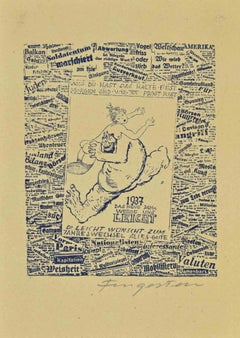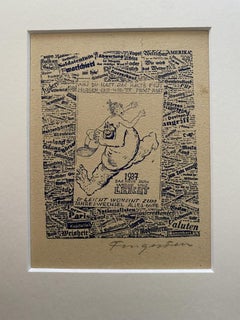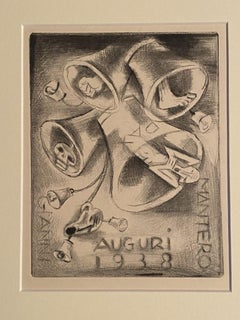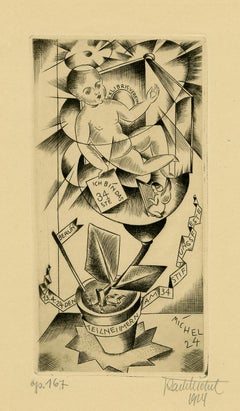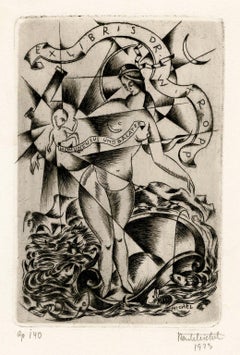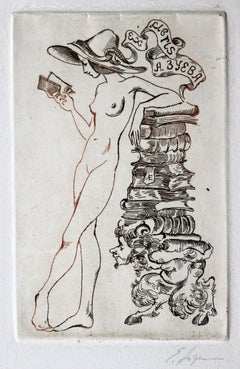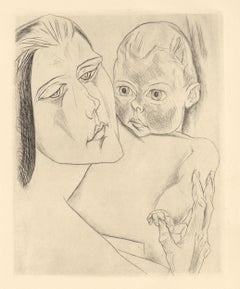Items Similar to Ex Libris Good Luck - Etching by M. Fingesten - 1930s
Want more images or videos?
Request additional images or videos from the seller
1 of 3
Michel FingestenEx Libris Good Luck - Etching by M. Fingesten - 1930s1930s
1930s
$538.52
£400.03
€450
CA$742.92
A$816.67
CHF 429.21
MX$9,917.40
NOK 5,354.24
SEK 5,072.77
DKK 3,425.63
About the Item
Ex Libris - Ex Libris - Good Luck is an original etching artwork realized by Michel Fingesten in the 1930s
Good conditions.
Original titled printed on plate: VIEL GLÜCK WÜNSCH S.MALZ
Includes passepartout : 49 x 34 cm
Ex Libris is a Latin phrase meaning a bookplate that identifies the owner of the book into which it is pasted.
Michel Fingesten
Michel Finkelstein, known as Fingesten, was born in 1884 in Buzkovice u Ostravy; he was a painter and engraver, who was famous particularly for his extraordinary production of Ex Libris (bookplates).
After studying at the Academy of Fine Arts in Vienna, and in Monaco with Franz von Stuck, who addressed him to the caricature and to the graphics of small size, Fingesten left Austria; he travelled all over the world, visiting Europe, the United States of America and the Oriental countries.
Fingesten’s stay in Berlin since 1913 was decisive for his contact with the world of the engraving. After his adhesion to the New Secession, Fingesten destroyed his previous pictorial production and he decided to dedicate himself to the dimension of the engraving; even if he preferred the graphics, he continued to see himself as a “painter”.
The German city was characterized by a very dynamic artistic atmosphere that stimulated Fingesten. The engravings of this artist were published since 1915 in files and books in limited edition.
Fingesten’s works were published also in the famous periodicals of the expressionist avant-garde, like “Genius” and “Marsyas”, with the artists and the writers most important of his age.
Considered as a genius of the Ex Libris, that became with him a big art of small size, Fingesten realised more over than 1.500 of these brands of property since 1915. Fingesten’s Ex Libris were nourishment for the bibliophiles, who glued the bookplates on the first page of theirs books to indicate the property and who traded these Ex Libris.
The Ex Libris is a genre that doesn’t have confines and that can’t be reduced to indicate the name of the owner on the book, on which it is glued.
It left his old function of simple heraldic sign of property, and it became almost the projection of the bibliophile’s personality.
Even if he didn’t fall in the eclecticism, Michel Fingesten used generously the medium of the quote, in the subject, in the form and in the style.
In the 20s, for example, his art oscillates between Otto Dix and George Grosz, of which he overcomes the social critique and the erotism, and Karl Arnold of which he beats the irony.
The Great Depression of 1929 and the rapid advance of the Nazism contributed in a significant way to the progressive isolation of the Czech painter and engraver.
In the spring of the 1935, Fingesten left Germany and went to Italy, where he settled in Trieste and Milan.
The collector Mantero remembers about Fingesten’s Italian stay that “he lived in a home without furnitures” in Via Chiaravalle 11.
Mantero, who was one of the most important Fingesten’s customers of Ex Libris, wrote: “I understood he had a difficult and poor life for absence of money, but he didn’t have ambition of a rich life, indeed he told me that the earnings to buy some bread and a glass of wine were enough for him”.
In that period, the main means of subsistence were the commissions of the collectors of Ex Libris, especially the collectors of Milan and Como, members of the circle of friends of the art merchant Luigi Filippo Bolaffio.
Also known as “Picasso of the Ex Libris”, Fingesten explored this artistic medium and he elevated it with new and powerful expressive resources.
When the Ex Libris was detached from its practical function, the Artist began to create Ex Libris also for fake customers, for “famous contemporary people”, poets, musicians, and since 1928, for political men.
The Ex Libris, realised with a lot of graphic techniques, like the etching, the drypoint and the lithography, has always (with the graphics of occasion) the signature of the Artist, that underlines the awareness of his valour.
An important chapter of the production of this Artist was dedicated to the erotic Ex Libris, that for their irony were understood with difficulty by people that didn’t belong to the circle of the Artist.
Some of the most secret and rare erotic works by Fingesten are linked to the commissions of Gianni Mantero.
The dominant element of these engravings is the sarcasm, that is sometimes connected to a gloomy irony, and to the presence of the death, that coincided with the war, particularly in the last years of the Artist existence.
In his compositions, Fingesten was a narrator of life and death, of sex and love, of nightmares, hopes, art and poetry. His narration wasn’t without the time and the space, but it was at the center of the contemporary dimension, in the 20s and 30s of the anguished Europe that was going to the ruin.
We can underline that the relationship between the Artist and the customer had an important role in the definition of the power of these graphic works; actually the creative energy, that was born from the contact between the Artist inspiration and the customer personality, generates a strong expressive freedom.
After his death, Michel Fingesten and his works were forgotten; today there is a new attention to this very important artist and to his visionary sign.
Bibliography
• N. Nechwatal, Michel Fingesten – Das graphische Werk, Coburg 1984
• A. Tomasetig, Michel Fingesten: dalla collezione Cauti una mostra di ex libris e grafica d’occasione, 2005
• A. Parik, The unknown Michel Fingesten, Praha 2008
This artwork is shipped from Italy. Under existing legislation, any artwork in Italy created over 70 years ago by an artist who has died requires a licence for export regardless of the work’s market price. The shipping may require additional handling days to require the licence according to the final destination of the artwork.
- Creator:Michel Fingesten (1884 - 1943, Italian)
- Creation Year:1930s
- Dimensions:Height: 5.91 in (15 cm)Width: 4.34 in (11 cm)Depth: 0.12 in (3 mm)
- Medium:
- Movement & Style:
- Period:
- Framing:Framing Options Available
- Condition:Insurance may be requested by customers as additional service, contact us for more information.
- Gallery Location:Roma, IT
- Reference Number:Seller: M-1098161stDibs: LU65036970252
About the Seller
4.9
Platinum Seller
Premium sellers with a 4.7+ rating and 24-hour response times
1stDibs seller since 2017
7,707 sales on 1stDibs
Typical response time: 2 hours
- ShippingRetrieving quote...Shipping from: Roma, Italy
- Return Policy
Authenticity Guarantee
In the unlikely event there’s an issue with an item’s authenticity, contact us within 1 year for a full refund. DetailsMoney-Back Guarantee
If your item is not as described, is damaged in transit, or does not arrive, contact us within 7 days for a full refund. Details24-Hour Cancellation
You have a 24-hour grace period in which to reconsider your purchase, with no questions asked.Vetted Professional Sellers
Our world-class sellers must adhere to strict standards for service and quality, maintaining the integrity of our listings.Price-Match Guarantee
If you find that a seller listed the same item for a lower price elsewhere, we’ll match it.Trusted Global Delivery
Our best-in-class carrier network provides specialized shipping options worldwide, including custom delivery.More From This Seller
View AllEx Libris - Felicitas! - Etching by Michel Fingesten - 1937
By Michel Fingesten
Located in Roma, IT
Ex Libris - Felicitas is an Etching print created by Michel Fingesten in 1937.
Hand Signed on the lower right margin.
Good conditions.
Michel Fingesten (1884 - 1943) was a Czec...
Category
1930s Symbolist Figurative Prints
Materials
Etching
Ex Libris - Woodcut by Michel Fingesten - 1930s
By Michel Fingesten
Located in Roma, IT
Ex Libris is a woodcut print created by Michel Fingesten in 1937.
Hand Signed on the lower right margin.
Good conditions.
Michel Fingesten (1884 - 1943) was a Czech painter an...
Category
1930s Symbolist Figurative Prints
Materials
Woodcut
Ex Libris - Leicht - Etching by Michel Fingesten - 1930s
By Michel Fingesten
Located in Roma, IT
"Ex Libris - Leicht" is an etching on ivory-colorated paper by Michel Fingesten, Early 20th Century. Hand signed in pencil.
In excellent conditions: As good as new.
Michel Finges...
Category
1930s Symbolist Figurative Prints
Materials
Etching
Ex Libris - Etching by Michel Fingesten - 1930s
By Michel Fingesten
Located in Roma, IT
"Ex Libris" is an Etching, Ex Libris, on ivory-colorated paper by Michel Fingesten, in 1938 .
In excellent conditions: As good as new.
Not signed. In this artwork there is an inscr...
Category
1930s Symbolist Figurative Prints
Materials
Etching
Ex Libris - Marco Binnholz - Woodcut by Michel Fingesten - 1930s
By Michel Fingesten
Located in Roma, IT
Ex Libris - Marco Binnholz is a woodcut print created by Michel Fingesten.
Hand Signed on the lower right margin.
Good conditions.
Michel Fingesten (1884 - 1943) was a Czech pa...
Category
1930s Symbolist Figurative Prints
Materials
Woodcut
Ex Libris - Etching by Michel Fingesten - 1930s
By Michel Fingesten
Located in Roma, IT
"Ex Libris" is an Etching, Ex Libris, on ivory-colorated paper by Michel Fingesten .
In excellent conditions: As good as new.
Hand-signed in pencil, on the lower right. Numbered 47...
Category
1930s Symbolist Figurative Prints
Materials
Etching
You May Also Like
'Ex Libris Verein' — 1920s German Expressionism
By Karl Michel
Located in Myrtle Beach, SC
Karl Michel, 'Ex Libris Verein' (New Year's Ex Libris Club Announcement), etching, 1924. Signed, dated, and numbered 'op. 167' in pencil. Signed and dated in...
Category
1920s Expressionist Figurative Prints
Materials
Etching
'Ex Libris Dr. Witropp' — German Expressionism
By Karl Michel
Located in Myrtle Beach, SC
Karl Michel, 'Ex Libris Dr. Witropp - Homunculus und Galatee', etching, 1923, edition not stated. Signed, dated, and numbered 'Op. 140' (the artist's inventory number) in pencil. Si...
Category
1920s Expressionist Figurative Prints
Materials
Etching
Ex Libris. Paper, etching, 11x7 cm
Located in Riga, LV
Ex Libris A. Zuyeva
Paper, etching, 11x7 cm
Category
1990s Jugendstil Nude Prints
Materials
Paper, Etching
$172 Sale Price
20% Off
"Mutter und Kind" original etching
Located in Henderson, NV
Medium: original etching. Printed on laid paper in 1919 for Genius. Plate size: 9 1/2 x 7 1/2 inches (240 x 190mm). This etching is from GENIUS: Zeitschrift fur Werdende und Alte Kun...
Category
1910s Expressionist Portrait Prints
Materials
Etching
'Viel Gluck 1923' — New Year's Greeting - German Expressionism
By Karl Michel
Located in Myrtle Beach, SC
Karl Michel, 'Viel Gluck 1923 Wunscht Karl Michel', etching, 1923, edition not stated but small. Signed, dated, and numbered 'op. 136' in pencil. Signed in the image, lower right. A...
Category
1920s Expressionist Figurative Prints
Materials
Etching
'Viel Gluck 1923' (Good Luck Wishes) — German Expressionism
By Karl Michel
Located in Myrtle Beach, SC
Karl Michel, 'Viel Gluck 1923 Wunscht der Graphikverlag, J.G. Holzwarth/Bad Rothenfelde', woodcut, 1922, edition 20. Signed and numbered op. 135d and 20/20 in pencil. Signed in the image, lower left. Annotated 'Vorgesdruck' [artist’s proof] in pencil. A fine, richly-inked impression, on heavy, cream Japan paper, with full margins (5/8 to 1 1/8 inches), in good condition. With the artist’s blind stamp in the top left margin. Printed by the artist. Matted to museum standards, unframed.
New Year's Greeting - "1923, Good Luck Wishes from the Graphic Press, J.G. Holzwarth/Bad Rothfelde."
Image size 5 x 3 1/2 inches (127 x 89 mm); sheet size 6 5/8 x 5 7/8 inches (168 x 149 mm).
ABOUT THE ARTIST
Karl Michel (1889-1984) was a noted graphic designer and expressionist printmaker during Germany's pre-Nazi Weimar Republic (1919-1933). Michel’s work was the subject of a feature article in the influential German graphic design magazine Das Plakat (The Poster) in 1920. An anti-war advocate, Michel created a suite of 12 wood engravings depicting his impressions of the humanitarian toll of WWII entitled ‘Humanitas’ (Humanity). The German publishing house Greifenverlag published the series in a reduced folio of unsigned prints.
Michel’s graphic work is held in the permanent collections of the Auckland War Memorial Museum (New Zealand), Frederikshavn Kunstmuseum & Exlibrissamling (Denmark), Museum of Applied Arts (Budapest), The Robert Gore Rifkind Center for German Expressionist Studies at the Los Angeles County Museum of Art, and the German Expressionism...
Category
1920s Expressionist Figurative Prints
Materials
Woodcut
More Ways To Browse
Warner Kreuter
Washerwoman Renoir
Weyman Lew On Sale
Whitford Carter
Will James Prints
William Peabody
Woodblock Zodiac
Yvonne Cole Meo
1970s Dali Painting
Al Hirschfeld Big Band
Alain Manesson Mallet On Sale
An Homage To Ikb
Anatole Krasnyansky On Sale
Andrew Wyeth Signed Print
Andrew Wyeth Signed
Andy Warhol Dragon
Andy Warhol Golda
Andy Warhol Lifesavers
